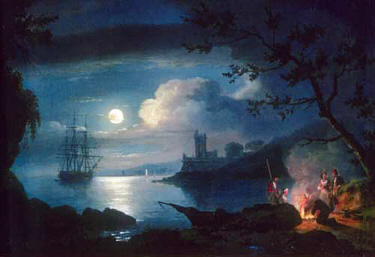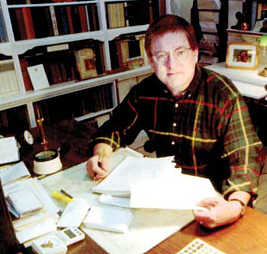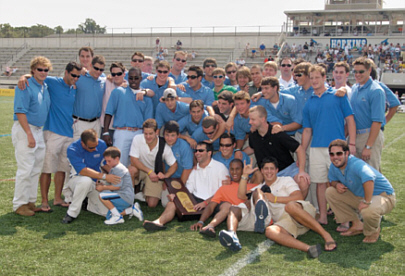






 |
||||
 |
 |
 |
 |
 |
 |
||||
|
N O V E M B E R 2 0 0 5 Alumni News
Editor: Philip Tang, A&S '95 | |
|
For more alumni info visit alumni.jhu.edu
Follow this link to
Send email to |
Roger Ekirch, A&S '74 (MA), '78 (PhD)
Decades ago, inspired by the suggestion of an old friend
from graduate school at Johns Hopkins, Roger Ekirch began
to research and write a history of nighttime. Three
children, five grants, eight fellowships, and 20 years
later, Ekirch has published At Day's Close: Night in
Times Past (W.W. Norton, 2005). |
 Roger Ekirch used this 17th-century painting, Return
from the Fields, by Peter Paul Rubens, to set the tone
for his book, At Day's Close.
Roger Ekirch used this 17th-century painting, Return
from the Fields, by Peter Paul Rubens, to set the tone
for his book, At Day's Close. |
 Along the way, Ekirch, now a history professor at Virginia Tech, combed thousands of letters, diaries, court records, proverbs, poems, periodicals, and other sources for whatever light they could shed on night's pleasures and perils. He found observations ranging from the coarse (Thomas Middleton's dismissive "no occupation but sleepe, feed, and fart") to the poetic (Shakespeare's image of "sleep that knits up the raveled sleeve of care"). "Half of human history has largely been ignored," says Ekirch, whose widely acclaimed book does much to fill that void. "Night wasn't just a meal followed by sleep. There was a tremendous amount of activity at night. It formed a distinctive culture in its own right." One vital activity, for households and cities alike, was "shutting in": battening down the hatches against the burglars, beasts, and spirits that roamed the night. Theoretically, candles, lanterns, and fireplaces could keep darkness and danger at bay; in practice, though-in the heyday of wooden buildings and thatched roofs-fire was even more dreaded than darkness. Mandatory blackouts, or curfews (from the French coevre-feu, "cover fire"), helped keep cities from burning, but at the price of prolonged darkness. To add teeth to their curfews, some towns stretched massive chains or logs across their streets; Nuremberg deployed more than 400 chains each night.
Paradoxically, night was often a time of revelry,
reflection, and hard work, too, explains Ekirch.
Gravediggers, watchmen, and "nightmen" (sanitation workers
who emptied public privies) toiled by night. So did
glassblowers and millers, so as not to waste the hard-won
heat of their furnaces or the constant power of their
waterwheels. Communal labors-quilting bees, spinning bees,
and corn huskings-combined work with games and gossip. |
 Roger Ekirch
Roger Ekirch |
 For the disenfranchised-the poor, the disfigured, slaves,
homosexuals, religious dissenters-night offered refuge, a
social leveling. The Adamites, a religious sect that sought
to recapture the innocence of the Garden of Eden, held
nighttime services where they worshiped in the nude.
American slaves visited spouses on neighboring plantations
or held midnight dances.
For the disenfranchised-the poor, the disfigured, slaves,
homosexuals, religious dissenters-night offered refuge, a
social leveling. The Adamites, a religious sect that sought
to recapture the innocence of the Garden of Eden, held
nighttime services where they worshiped in the nude.
American slaves visited spouses on neighboring plantations
or held midnight dances.According to Ekirch, other nocturnal gatherings were more sinister. In cities across Europe, gangs of armed men-peasants and nobles alike-roamed the dark streets, raping, dueling, and brawling. Centuries ago, London was terrorized by forerunners of the Crips and Bloods: the Scowrers, the Hectors, and the American Indian-inspired Mohocks, notorious for knifing pedestrians in the face. ("They shan't cut mine," wrote Jonathan Swift, who gave up walking at night, shelling out a gold crown a week for sedan chairs-taxis-instead.) The most striking difference Ekirch found between "then" and "now" had to do with sleep itself. "Early on in the research, I was in London looking at court depositions," he recalls, "and I started seeing references to something called 'first sleep.' Then I started noticing references to 'second sleep.'" Years later, he read about an experiment that recreated "prehistoric sleep": sleep in tune with the rhythms of day and night, without interference from artificial light. In that experiment, human subjects gradually gravitated toward "segmented sleep," which was divided into two distinct periods, separated by an hour or two of wakefulness. Ekirch's sources indicated that some people devoted this interval to contemplation; others, to copulation. Peasants and artisans-exhausted by their labors-tended to conceive their offspring "after their first sleep," concluded a 16th-century French physician, adding "they have more enjoyment" and "do it better." (Sequel suggestion: The Historian's Guide to Better Sex.)
You might suspect that a 20-year investigation of life's
dark side would be the work of a diehard night owl, but
you'd be wrong. "My attraction to this topic was purely
intellectual curiosity," says Ekirch. "Beyond walking the
dog at night, I don't claim any special bond with nocturnal
darkness. In fact, I consider myself a morning person."
Doris Zimmerman, Nurs '53, SPSBE '53, A&S '80 (MLA)
Parliamentary procedure may seem like an antiquated
subject. After all, it was Thomas Jefferson who first
compiled The Manual of Parliamentary Practice, which
presented a uniform set of rules for American colonies that
disagreed about nearly everything-from how to elect
officials to the process of a democratic meeting. |
 Doris Zimmerman
Doris Zimmerman |
 But the rules are far from obsolete, says Doris Zimmerman,
a professional registered parliamentarian. Today,
governments, school organizations, businesses, and
community clubs follow a similar protocol based on
Robert's Rules of Order. An arcane 643-page book
first published in 1876 by Brig. Gen. Henry Martyn Robert,
Robert's Rules is "too much for the layman,"
Zimmerman says.
But the rules are far from obsolete, says Doris Zimmerman,
a professional registered parliamentarian. Today,
governments, school organizations, businesses, and
community clubs follow a similar protocol based on
Robert's Rules of Order. An arcane 643-page book
first published in 1876 by Brig. Gen. Henry Martyn Robert,
Robert's Rules is "too much for the layman,"
Zimmerman says.So she published Robert's Rules in Plain English in 1997 to help the rest of us wade through the jargon. "Parliamentary procedure is basically logical," she says, "and I felt the important points could be presented simply." Zimmerman's book is a concise and modern manual that uses the fictional Green Acres Association to walk the reader through rules such as how to prepare an agenda, take minutes, make different types of motions, and change bylaws. Charts, outlines, and dialogue make it easy for any group to run a democratic meeting that protects the rights of individual members and the majority. In recent years, digital media have revolutionized the way some businesses are holding meetings. And behind computers, Zimmerman says, "many users are not applying democratic principles," resulting in unproductive and confusing meetings. So she updated her book with a second edition, released in September. The new edition describes rules unique to electronic meetings. For example, "no state recognizes an e-mail meeting as legal," says Zimmerman. She also warns that complex issues, or topics that require negotiation, may be difficult to discuss via electronic media. But certain rules and etiquette exist: "Respect time limits set for a debate," Zimmerman instructs, which can help videoconferences and conference calls run more smoothly.
Zimmerman, who founded Parliamentary Consultants Inc. to
help groups implement Robert's Rules, is now
retired. She says she is pleased with the positive
reception to her books. "My motivation," she says, "was to
leave something when I retired that is easy to
understand."
Chris Henze, Bol '77 Chris Henze calls it the "the last great sailing ship gunnery duel in history" and "a forgotten episode of the Civil War." It happened-of all places-just off the coast of Cherbourg, France.
In 1864, the CSS Alabama, a Confederate cruiser that
enjoyed an extraordinarily successful career as a commerce
raider, docked at Cherbourg for repairs. In pursuit, the
USS Kearsarge arrived outside the harbor soon after. It
agreed to wait until the Alabama was coaled, and five days
later, the Confederate ship sailed through the breakwater
to meet what would be its final opponent. After more than
an hour of heavy combat, thousands of Parisian onlookers
watched the Alabama sink to its watery grave almost 200
feet below. |
 The French Navy vessel Elan brings the CSS Alabama's
cannon up from the wreck site. Below, an 1862 print of the
ship.
The French Navy vessel Elan brings the CSS Alabama's
cannon up from the wreck site. Below, an 1862 print of the
ship. |
 It remained there for 120 years, lost until a French Navy minesweeper found it in 1984. The discovery set in motion a chain of events that led to Henze's work in the scientific exploration of the wreck. This summer, he supervised 252 individual dives. (There have been more than 2,000 dives since they began in 1988.) "No day is typical," Henze says. As acting president of Association CSS Alabama, Henze is responsible for securing diving permission from the Ministry of Culture and the French Navy; procuring lodging and insurance for French volunteer and American professional divers and archaeologists; and gathering the necessary vessels and equipment. All the work has led to plentiful booty. The most recent was a second pivot gun recovered this summer, the largest object ever raised from the Alabama. The first pivot gun, raised in 1994, was still loaded with a live shell and required explosive experts to defuse it. According to Henze, the shell's black powder was perfectly dry. A large crab also decided to call that gun home. "I believe it ended in a French diver's cooking pot," says Henze. The Alabama's guns and the cannon are of interest to historians. In 2002, one cannon even turned up the first human remains-two mandible fragments that likely belonged to a British sailor from the Alabama.
Henze's passion for the shipwreck was born from his earlier diplomatic work in Geneva, where he served at the U.S. Mission to the United Nations and Other International Organizations from 1984 to 1988. He was searching for a suitable venue for the 1985 Reagan/Gorbachev Summit when he discovered the Alabama Room at the Geneva City Hall. In 1872, the Alabama Room was the stage for the first international arbitration tribunal in history, which awarded the United States-still angry that many Confederate warships had been built in British shipyards-$15.5 million in gold as compensation for Britain's apparent violation of laws of neutrality. Henze's next assignment was to the U.S. Embassy in Paris as cultural attachˇ in 1988. By this time, negotiations had already started between France and the United States over ownership of the wreck and its artifacts. Henze says he gladly took over the position of liaison officer in the discussions. "Interestingly, our naval attachˇ at the time wanted nothing to do with CSS Alabama. He still considered it an enemy ship and said he wouldn't touch it with a 10-foot pole," Henze says. After three years of discussions, the French government agreed in 1991 that, even though the Alabama was now in French waters, the United States officially owned the wreck and artifacts. The Association CSS Alabama was designated to conduct the exploration of the wreck. Henze retired from the Foreign Service in 1992 and joined Association CSS Alabama at the age of 50 because of his "fascination with so many aspects of the Alabama story: the ship, her captain and his accomplishments, the battle, the arbitration, the ownership negotiations, and the joint scientific work," he says. A lot remains to be done, however, including the recovery of the galley stove that divers found too difficult to retrieve this summer. "It was full of live lobsters," Henze jokes. On a serious note, Henze says that while most of the early support and funding for the project came from France, with more recent funding from the U.S. government, this summer's diving project might be the last until another generation can bring new technology and additional financial support. — KH
Beth Vincent, SPH '97
Discouraged by the dearth of healthy snack options during
her own pregnancies, Vincent decided to create a convenient
snack that doubled as a pre-natal vitamin supplement. She
researched the market, found no such product existed, and
thought, "Let's see if we can fill that void." |
 A mother of three, Beth Vincent created Oh Mama bars to
help pregnant women stay healthy.
A mother of three, Beth Vincent created Oh Mama bars to
help pregnant women stay healthy. |
 With a master's degree in health policy and management from
the Bloomberg School
and experience as a health care consultant, Vincent was
able to draw from her expertise in maternal and infant
health to make Oh Mama. She launched the bar in April, and
shortly thereafter, won the International Juvenile Product
Manufacturer Association's Innovative New Product Award.
With a master's degree in health policy and management from
the Bloomberg School
and experience as a health care consultant, Vincent was
able to draw from her expertise in maternal and infant
health to make Oh Mama. She launched the bar in April, and
shortly thereafter, won the International Juvenile Product
Manufacturer Association's Innovative New Product Award.As co-founder (with her husband) of Vincent Foods, she does her best to juggle the roles of entrepreneur and mother. "Working from home with three small children means often much of my work occurs in the evenings after the kids are asleep," Vincent says. And the work won't let up anytime soon. She just signed with Whole Foods to sell Oh Mama and expects to add two new food products to the Vincent Foods line early next year. —KH
Extreme Makeover: Gilman Edition
The new building-the first academic building on the Homewood campus-housed classrooms, seminar rooms, offices, and libraries for all of the humanities and social sciences departments. Hopkins' pioneering approach combined research and teaching under one roof, a novel idea in America at the time. That was 1915. Ninety years later, the landmark building is still home to a stellar cadre of scholars who continue the tradition of academic excellence set in motion when Gilman Hall first opened. But with its aging heating and cooling systems, dimly lit hallways, antiquated floor plan, and inadequate technological capabilities, the building has not kept up with the scholarship it houses. "Gilman Hall is the home of humanities, and the heart of the Krieger School," says Adam F. Falk, interim dean of the Zanvyl Krieger School of Arts and Sciences. "It has to be a place that is worthy of the work that goes on there. We can't think about doing modern work in the humanities without a modern place for people to do that work." Inside Gilman Hall, 21st-century Hopkins scholars are organizing highly acclaimed historical exhibits such as a monumental collection of Egyptian artifacts and another of ancient American art. The humanities continue to expand at Hopkins, with new programs in the works, such as a multi-disciplinary minor in museum studies and growing centers in Africana and Latin-American studies.
"Humanists don't need space and equipment in quite the same
way as scientists do. But they need classrooms in which
they can control the temperatures," says Frances Ferguson,
an English professor and past chair of the building's
planning committee. "The idea is to restore Gilman Hall so
that it reflects the spirit and the kind of educational
activities that Hopkins is known for." |
|
"Gilman Hall is the home of humanities, and the heart of
the Krieger School. . . . We can't think about doing modern
work in the humanities without a modern place for people to
do that work." —Adam Falk, Interim Dean |
Next fall the Homewood campus's most recognizable building
is slated to begin a multiphase, $35 million renovation.
When it is complete, Gilman Hall will house the Krieger
School's 11 humanities departments, fostering
interdisciplinary learning and research among the faculties
that are now spread out across the campus in three
buildings. Plans call for an interior redesign that will create a better organized floor plan with more office space for faculty and graduate students. Improvements will also include an update of the building's infrastructure and mechanical systems, more natural lighting, and wired classrooms with access to the Internet and video-conferencing. The ground floor, which is to be completed in the renovation's first phase, will be home to the three departments directly concerned with the study of art and archaeology — Near Eastern Studies, History of Art, and Classics. Each department will have access to a new gallery that will feature exhibitions from the school's collections of antiquities of the ancient Near East, Egypt, Greece, Rome, and the ancient Americas, as well as the Hopkins photo, slide, and electronic image archives. The renovation of Gilman Hall is a key priority of the larger Humanities Initiative, a fundraising effort that is part of the Hopkins Knowledge for the World campaign. The initiative also aims to build endowments for professorships and fellowships in the humanities. Support of the liberal arts and humanities is as crucial as support of science, engineering, and medicine, says Gabrielle Spiegel, who chairs the History Department and is acting dean of faculty of the Krieger School. "You cannot become a good physicist or a good surgeon if you cannot initially learn critical thinking," Spiegel says. In today's changing world, the work of the humanities-and support of that work-is critical, says Stephen G. Nichols, the James M. Beall Professor of French and Humanities and chair of the Romance Languages and Literatures Department. For example, a decade ago, 'jihad' was not a common word in the American vocabulary, Nichols explains. But today, most people are familiar with this term for a Muslim holy war because of a worldwide resurgence of religious fundamentalism. Given the complexity of the new condition, humanists need to step in and help us understand. "The world has gotten larger, so we need to know more," Nichols says. "We need to know why there are problems." And humanists at Hopkins have engaged that kind of purposeful thinking since before Gilman Hall opened its doors. Today, that effort comes with the need for a world-class facility and sustained support for professorships, graduate fellowships, and scholarship, Nichols says. To continue the work that has earned Hopkins' humanities its outstanding reputation, the school needs the funding to attract the top students and faculty with salaries, fellowship stipends, and a modern home. "We do it better than anyone else in the world," Nichols says. "All of this is threatened if we can't be competitive." —Nora Koch
On September 10, the Johns Hopkins community commemorated
the 2004-2005 men's lacrosse team's undefeated season and
NCAA championship. The 2005 team and coaching staff were in
attendance as the Blue Jays signed autographs in front of
the Newton H. White Athletic Center prior to the first home
football game of the season. At half time, the team
received a boisterous ovation at Homewood Field. |
 The 2004-2005 men's lacrosse team returned to Homewood
for a celebration of their NCAA championship
victory.
The 2004-2005 men's lacrosse team returned to Homewood
for a celebration of their NCAA championship
victory. |
 The festivities culminated in a ring ceremony at the Hunt Valley Marriott in Baltimore, where the 2005 team members received their diamond-studded, personalized championship rings. The ballroom was filled with memorabilia from the 2005 season, including helmets, jerseys, and photographs. Footage of the season's highlights was projected onto a screen, concluding with the national championship game against Duke.
"I am proud to be part of this team," said Kyle Harrison,
A&S '05, co-captain of the 2005 Blue Jays. "It was a
privilege to bring the championship back to Hopkins-where
it belongs."
In August, forensic psychiatrist and Court TV resident expert Keith R. Ablow, Med '87, published Inside the Mind of Scott Peterson (St. Martin's Press), which quickly climbed to No. 10 on the New York Times Bestseller List. Ablow has testified in some of America's most highly publicized trials and appeared on Today and Oprah. Alvin Deutsch, A&S '53, has been named one of the New York area's best lawyers by New York Magazine. He was a senior partner of an intellectual property firm for more than 30 years prior to joining McLaughlin and Stearn LLP, where he specializes in entertainment law. Leslie Sanchez, SPSBE '02 (MBA), is competing to be Martha Stewart's apprentice on the NBC reality TV series. Sanchez is president and owner of Impacto Group LLC, a Washington, D.C.-based strategic communications and marketing firm. She was President George W. Bush's point person on education issues pertaining to the Hispanic community, and, in 2001, was named one of Hispanic Business's "100 Most Influential Hispanic Americans." Marie-Hélène Carleton, SAIS '98, has published, along with fiancé Micah Garen, American Hostage: A Memoir of a Journalist Kidnapped in Iraq and the Remarkable Battle to Win His Release. In 2003, having completed the filming of a documentary in Iraq, Carleton headed back to New York. Two days before his scheduled departure, Garen and his translator were kidnapped. American Hostage alternates Garen's account of captivity with Carleton's efforts to secure his release. |
 |
|
 The Johns Hopkins Magazine |
901 S. Bond St. | Suite 540 |
Baltimore, MD 21231
The Johns Hopkins Magazine |
901 S. Bond St. | Suite 540 |
Baltimore, MD 21231Phone 443-287-9900 | Fax 443-287-9898 | E-mail jhmagazine@jhu.edu |
|